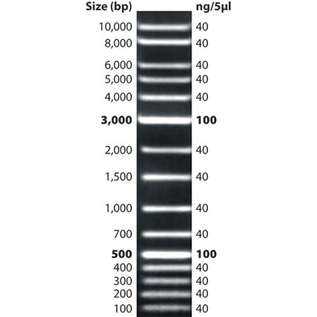A DNA ladder, also known as a molecular size marker or standard DNA marker, is a solution containing DNA fragments of varying lengths and sizes that serves as a reference in estimating the size of unknown DNA molecules after they are separated by agarose or acrylamide gel electrophoresis. DNA ladders are the mainstay in every laboratory that routinely performs DNA experiments.
DNA ladders can be used in several ways. Aside from determining the size of unknown DNA fragments based on molecular weight or number of base pairs, they can also be used to differentiate between DNA variants, determine the number of mutations in particular DNA fragments, aid in the interpretation of the results of diagnostic samples. DNA ladders are also used to measure the polymer length of inorganic polyphosphates resolved by polyacrylamide gel electrophoresis (PAGE).
Earlier, commercial DNA ladders were prepared through the amplification by polymerase chain reaction (PCR) or the digestion of plasmid DNA by restriction endonucleases. However, recent advancements allow for the preparation of DNA ladders using a combination of the two methods.
What Makes an Ideal DNA Ladder?
- The ladder is highly purified and does not contain any unwanted or unessential fragments.
- Individual fragments are easily separable.
- Fragments have enough concentration to allow for easy visualization on a gel.
- The specificity of the DNA ladder is not affected by the gel loading dye.
- The fragments are stable enough and can be used for a longer time.
What are the Types of DNA Ladders?
There are several types of DNA ladders that can be used in your experiments. They are classified according to the number of fragments present or the length of the target DNA fragments to be identified.
1 KB DNA Ladder
The 1 KB (1000 bp) DNA ladder, which contains 13 DNA fragments with reference bands at 1000 and 3000 bp, allows for the quick and easy determination of electrophoresis results and can be used to accurately determine the size of DNA fragments from 250 to 10,000 base pairs (bp).
Commercially prepared 1 KB ladder can be resolved in 0.75% to 1% agarose or polyacrylamide gels and are premixed with loading dyes (such as bromophenol blue and xylene cyanol FF). 1 KB ladders are available in different concentrations but a 5µl loading concentration is recommended to achieve ideal results.
These ladders can be stored at varying temperatures in storage buffers (such as 10 mM Tris-HCl or 1 mM EDTA) to extend their shelf life. For example, they can be stored at 25
1 KB Plus DNA Ladder
With 15 DNA bands ranging from 100 bp to 10 KB and reference bands at 1000 and 3000 bp, the 1 KB Plus Ladder can be effectively used to determine longer DNA fragments with lengths ranging from 250 bp to 25,000 bp. Much like the 1 KB ladder, these reagents are ready to use and are compatible with 0.7% to 1.0% agarose and polyacrylamide gels.
DNA ladders are also available in other sizes:
- 20 bp – consists of 13 DNA fragments with 60 to 300 bp and is helpful in identifying smaller DNA fragments
- 50 bp – contains 10 DNA fragments with sizes ranging from 500 bp to 5.0 KB
- 50 bp plus – has 13 DNA fragments with sizes ranging from 50 to 1000 bp
- 100 bp – consists of 11 DNA fragments with sizes ranging from 100 to 1500 bp
- 100 bp plus – has 14 DNA fragments with sizes ranging from 100 to 3000 bp
- 500 bp - contains 10 DNA fragments with sizes ranging from 500 bp to 5.0 KB
Image: DNAmark 1kb PLUS Marker

Reference & tagged content for this blog is:



